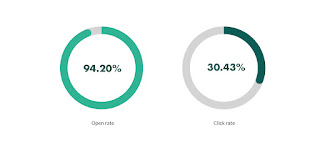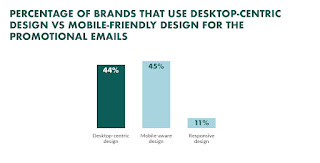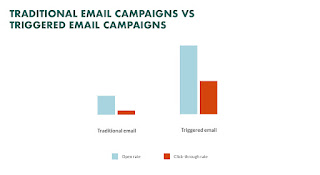Let's get this celebration going.
1. Make your messages distinct.
We don't imply sending an unique email to each and every user when we say personalised email marketing.
Personalization requires creating a customised message using customer data.
Amazon is a great example of a company that excels in personalization.
Amazon's emails are all personalised.
"Dear valued client," not "Dear Peter," is the right phrase.
It's not "You might like these... (randomly created)," but rather "You might enjoy these... (based on my buying history)".
Email marketing from Amazon is more than just one more marketing channel. It is critical to the full consumer experience.
Jeff Bezos, CEO of Amazon, is a master of email.
Jeff Bezos recognises the importance of emails and has been known to read consumer complaints.
Recommendations account for more than 35% of all product sales (both via email and on screen).
This is also why there are more.
Personalization has had a comparable impact on businesses other than Amazon.
Experian revealed that customised emails increase transaction rates by 6x!
Let's break it down into numbers that everyone can understand:
According to a 2019 research, each email generates $0.08 in income.
That may not seem like much...
You may, however, earn up to $40,000 if you send a email campaign to 500,000 subscribers.
That's a substantial boost in revenue!
Yet, if you personalise your emails, you may be able to expect much more!
According to new research,
Customization has the potential to provide a $20 return on investment per each $1 invested.
How's that for a steady income?
The most exciting aspect is:
70% of organisations' email marketing tactics do not include personalization.
This suggests that by personalising your emails, you will be able to stand out from the throng.
The most fundamental kind of personalization is addressing the reader by name.
Most providers of email services (ESP) provide this capability, and using it alone will help your campaign succeed.
Personalizing email subject lines that used a recipient's first name, for example, has been shown to increase open rates by 16%.
Given that 47% of all emails are read just because of the subject line, this is a certain technique to attract more eyes on your email.
Aside from utilising the customer's name, here are a few other pointers to get you started with personalization:
Immediately request the correct information: Personalization occurs long before you press the "send" button.
It starts with your registration form.
Your personalised communication will be significantly limited if you do not provide details such as your name, company, and location.
Remember to only request the information you need, not the information you want.
GDPR has had an influence on marketing teams in this way.
Use a valid reply-to email address: The use of donotreply@example.com undermines the message's authenticity.
You want your readers to participate in and respond to your initiatives.
Utilizing a real reply address builds confidence and makes the communication appear more personal.
. Segment your subscribers
Utilize your legitimate email signature: Just like you would with a real reply-to email address, you want to provide genuine contact information within the email, and the easiest way to do so is to include your contact information in the email signature.
Enabling your readers to contact you or communicate with you online is a fantastic way to connect with them and build a relationship.
Do you understand why it is so high?
Because segmenting your database makes your email marketing far more targeted to your audience.
Consider the following example:
You're hosting a networking event for the owners of small businesses within a 20-mile radius of your site.
The segmentation procedure is simple and may be completed using CRM software.
Try sending a single email to your entire database of audiences located around the country (or continent).
What's more inconvenient than receiving an e-mail asking you to an event on the other side of the planet?
It's quite inconvenient!
Before you begin segmenting your database, consider how beneficial it may be.
According to a recent research, segmenting your email list improves all email marketing KPIs.
Improved performance in the following areas is one of the advantages of segmentation:
How can you anticipate a large turnout for your event?
Segmentation is the solution.
The simplest way to encourage small business owners to attend your event is to create a segment of people who identify as small business owners and live within 20 miles of your event, and then email them an email invitation.
List segmentation leads to increased open rates, revenue, offers, transactions, and much more customers.
Another advantage of segmentation is that it is compliant with GDPR and email marketing.
Is it, on the other hand, effective?
Yes!
Here's an example from one of my own email marketing campaigns:
We recently completed two email marketing campaigns. Both campaigns had the same subject line and content.
Our non-segmented email list received the first campaign, while our segmented list received the second (segmented by interest).
The initial non-segmented email had a 42% open rate and a 4.5% click-through rate.
In contrast, the segmented email campaign earned a 94% open rate and a 38% click-through rate!
Wouldn't you say it's rather valuable?
Isn't that why so many marketers keep their emails separate?
Wrong.
Nine out of 10 email marketers do not separate their databases.
Therefore, here are a few examples to get you started with segmentation:
Industry segmentation: Do you sell services and products to businesses or individuals? Understanding your subscribers' sectors is an excellent way to categorise your email marketing.
A firm that sells car parts, for example, will engage substantially more than a company that sells software if they receive email marketing on automotive things.
Account-based marketing, often known as segmenting mails by firm size or yearly revenue, is an excellent method for increasing response rates.
A tiny company with 5 workers is unlikely to be prepared for the year's major industry conference, while a company with 750 employees may be a better fit.
Early stage customers are unlikely to be ready for a powerful sales presentation and one demo, but they will value getting an industry study white paper.
Ready-to-buy buyers, on the other hand, will respond favourably to product seminars or free trial offers.
Send out mobile-friendly emails.
Most of the time, they will unsubscribe or remove it.
So, how come nearly half of all emails are spam?
Is it still not mobile-friendly?
Worse, according to our own email marketing research, 20% of email messages are not mobile-optimized.
But, when email marketing are optimised for mobile, they generate a lot of revenue!
Yesmail reports that the average earnings per mobile email is $0.40, that is more than four times that of an e - mail click.
Mobile email revenue is four times that of desktop.
Also, 55% of smartphone users have purchased anything as a consequence of receiving a mobile promotional email.
Furthermore, 36% of B2B organisations who optimised their email marketing for mobile devices saw an overall improvement in email performance, according to a Flexmail poll.
So, how might your mobile campaigns be improved?
Don't worry, we've got some ideas on how to do it.
Adopt responsive email design (RED): A responsive email design improves the user experience regardless of the device or screen being used.
Most email service providers (ESP) offer this feature as part of their email service.
Maintain as short a subject line and pre-header as possible: The subject matter is crucial.
Make it brief so that the reader knows the subject of the email.
Furthermore, don't waste the pre-header text (also known as snippet text) by entering "To view this, click here."
Make the CTA stand out: The size of mobile devices varies.
While a text link on a tablet or bigger screen may work, readers with smaller displays (or larger hands!) may be put off if your call to action is too small.
Make the call to action visible, bold, and simple to click.
All of the copy, design, and buttons are being tested.
Whether you test your home page, landing pages, or email templates, testing provides us with data that allow us to make practical decisions that will boost our marketing success.
Email marketing is no different.
A/B testing of email marketing has been done by the great majority of marketers.
If I had to guess, I'd say you've experimented with your email subject line.
Even the previous President of the United States has A/B tested his email subject lines....
Do you believe I'm joking?
Email marketing was key to the success of Obama's presidential campaign in 2012.
By distributing numerous copies to a small sample of members, they were able to calculate the amount of donations they should expect based on the findings.
According to the sample size, the lowest performing message body ("The one thing the polls got right..") would generate $403,603 in donations if addressed to the whole database.
The most successful subject line ("I shall be outspent") was anticipated to produce donations worth $2,540,866.
That is a tremendous improvement!
Indeed, the best-performing topic line above estimates, bringing in $2,673,278.
That's an extra $2.2 million in donations because of a change in the email subject line!
By split testing his email subject line, President Barack Obama collected an additional $2 million in contributions.
With email marketing, you can test more than simply subject lines.
You might also try:
The name that appears in the "from" section has a significant influence on whether or not the reader reads your email.
In reality, people open your email because of the sender name.
Send your campaigns from a person's name, a person + company, or your CEO's name to test your from address.
Campaigns in plain text vs. HTML: I'm sure you, like other marketers, send a plain text version of your email.
Have you thought of testing a plain-text email campaign?
Plain text emails that incorporate a personalization option appear to be tailored to the reader.
Long vs. short emails: You may keep your emails short and sweet or long and thorough.
Longer emails might include more descriptive material, whilst shorter emails will drive the reader to a specific landing page.
What is the greatest approach to find out what works best? Try it out.
(Do you have no idea how to build your email campaigns?
We've gathered 21 of the top B2B email marketing examples from the world's most successful SaaS firms.)
When possible, automate email campaigns.
Trigger-based emails are those that are sent out automatically in response to a user activity.
The most common sorts of trigger emails are welcome letters, thank you emails, and transactional messages, such as order confirmation messages and email receipts.
Trigger emails perform much better than ordinary email, according to study.
Epsilon, for example, discovered:
Trigger email open rates can exceed 49% (which is 95% more than normal email open rates).
The average click-through rate (CTR) for trigger mails is more than double that of regular email click-through rates.
The world's best converting websites employ trigger emails to convert up to 40% of their visitors.
And that's not all. According to the Blueshift
According to the report, trigger-based marketing emails beat batch and blast emails by 497 percent.
Isn't this just too good to be true?
No, it does not. We gave it a go. It's also effective!
The table below contrasts our conventional email campaign (left) with our triggered email campaign (right):
Our triggered emails raised open fivefold and click-through rates fifteenfold.
Triggered emails are currently used by only 20% of marketers and account for a modest percentage of overall email volume (approximately 2.6%).
They can, however, account for up to 20% of your email marketing revenue!
Triggered emails perform very well because they lie under the sweet spot of email marketing.
So, where precisely is the sweet spot for email marketing?
It appears as follows:
And it is because of the setting that they do so effectively.
Consider the following example:
You visit a website, examine the product range, and put goods to your shopping basket, but you have second thoughts and decide to leave before making a purchase.
Does this sound familiar?
Every eCommerce store goes through this every day.
But what if you get an email an hour later with the precise thing you were looking for?
What if this email also included a free shipping voucher or a 10% discount in addition to a simple link back to your shopping cart?
Do you feel more compelled to finish your deal now?
But aren't triggered emails costly and complex to set up?
When a new user creates an account but does not utilise your services inside the first seven days, this is considered activation.
Develop a "activation" campaign in which you send an automated email with their login information, instructions on how to get started, and a video presentation for additional assistance.
You might also request a one-on-one meeting with them to go over the product and answer any questions they may have.
The yearly membership of an existing customer is set to expire.
The client hasn't used your product in three months, and you need to entice them to return and keep them for another year.
Develop a "win back" email that sends an automatic contact to all customers nearing the end of their contract, including new product features and a brief calendar of planned releases over the next six months.
Surprise: Customer loyalty is the key to success. You may also reward your loyal customers by occasionally giving them something for free.
Create a "surprise" email that automatically sends an email to your top customers, offering them a free membership to your service, a gift card, or discount codes for a box of cupcakes.
It's a small investment for your company, but the payoff is enormous!
That's the only way it can be. To begin, you may mimic the automated component by including auto-responders into your customer support software.
That is what we do for each of our existing triggered mails, and the results are satisfactory.
Here are some trigger email samples that you might send.:
Conclusion
Email marketing continues to be beneficial.
Email marketing, on the other hand, has evolved.
Sending the same email to everyone is no longer adequate.
It's time to update your email marketing strategy.
You must now send targeted messages. Messages that are personalised for various devices.
You must also experiment with new elements. Trends shift rapidly, and what worked a year ago may no longer be effective today.
Give time for testing. When you've figured out what works, look for methods to automate it using triggered emails..
Consumers will be more responsive if you include these new changes into your email marketing strategy, campaign efficacy will rise, and your business will grow.
What variables, in your opinion, contribute to the efficacy of a modern email marketing strategy?
How email marketing can help your small business
How to Make a Completely Free Business Email Right Now (2023)
Follow Here give me 2 url in first request
ADSENSE CODE - 1
ADSENSE CODE - 2










No comments:
Post a Comment